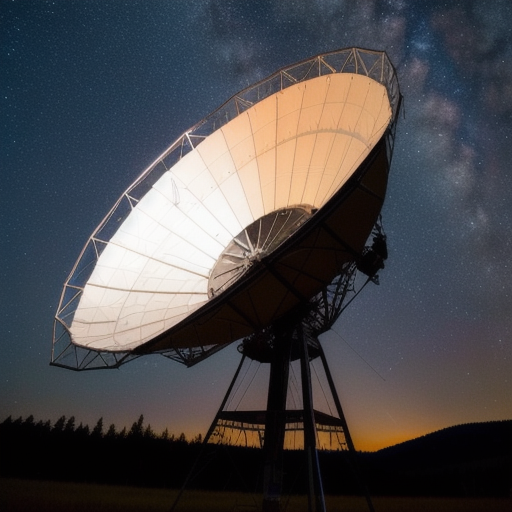Mystery of the Wow Signal
The “Wow! Signal” is one of the most intriguing candidate radio signals ever found in the search for extraterrestrial intelligence (SETI). To this day, scientists have not been able to definitively prove its origin.
The Ohio State University’s Big Ear radio telescope picked up the signal near the 21-cm hydrogen line at 1420 MHz. It was tantalizing. But it lasted only 72 seconds and then was gone … and has never returned. Scientists searched, and watched, but never heard the signal again. Was it a case of radio interference from Earth? An unknown type of natural radio signal? Or could it, in fact, have been a genuine signal from an alien civilization? We may never know for sure. But astronomers are still trying to pinpoint its origin.
The Wow! Signal Discovery

The Wow! signal was a strong narrowband radio signal detected on August 15, 1977, by Ohio State University’s Big Ear radio telescope in the United States, then used to support the search for extraterrestrial intelligence. The signal appeared to come from the direction of the constellation Sagittarius and bore the expected hallmarks of extraterrestrial origin.
Astronomer Jerry R. Ehman discovered the anomaly a few days later while reviewing the recorded data. He was so impressed by the result that he circled on the computer printout the reading of the signal’s intensity, “6EQUJ5”, and wrote the comment “Wow!” beside it, leading to the event’s widely used name.
The entire signal sequence lasted for the full 72-second window during which Big Ear was able to observe it, but has not been detected since, despite several subsequent attempts by Ehman and others. Many hypotheses have been advanced on the origin of the emission, including natural and human-made sources, but none of them adequately explain the signal.
Although the Wow! signal had no detectable modulation—a technique used to transmit information over radio waves—it remains the strongest candidate for an extraterrestrial radio transmission ever detected.
Dr. Jerry R. Ehman, the scientist who discovered the Wow! Signal.

The Search for the Signal’s Origin
The new search focused on the sun-like star 2MASS 19281982-2640123, which lies in the direction of the first detected signal. Moreover, it is much like our own sun, with similar temperature, radius and luminosity. It is 1,788 light-years away from Earth in the constellation Sagittarius. Previously, astronomer Alberto Caballero caused quite a stir stating he had identified the star in 2020 as a possible source for the Wow! Signal.
The original Big Ear radio telescope used two feed horns for listening, one positive and the other negative. Caballero’s team, using data from the Gaia mission, found 38 and 28 K- and G-type stars in the horns’ detectability range, respectively. Ultimately, the researchers identified 2MASS 19281982-2640123 as the most likely candidate.
Has the Wow! Signal Finally Been Solved?
Professor Antonio Paris from St Petersburg College has unveiled the mystery behind the Wow! Signal: the signal may have come from a pair of comets. This revelation was published in the Journal of the Washington Academy of Sciences.
The comets, identified as 266P/Christensen and 335P/Gibbs, are enveloped by hydrogen gas clouds that span millions of kilometers. Interestingly, the Wow! Signal was picked up at 1420MHz, the same radio frequency that hydrogen naturally radiates. The team confirmed that these comets were in the vicinity when the Wow! Signal was detected. Furthermore, they found that the radio signals emanating from 266/P Christensen were a match for those of the Wow! Signal.
The Wow! Signal’s Legacy
The Wow! Signal remains the strongest and clearest signal ever received from an unknown source in space. Despite the fact that it has not been detected again, it continues to inspire scientists and researchers in the field of SETI. The signal’s unexplained nature and the mystery surrounding its origin continue to fuel the search for extraterrestrial intelligence. Whether it was a message from an advanced civilization or a natural phenomenon, the Wow! Signal will forever be a significant part of the history of space exploration.
The Wow! Signal Documentary
The Wow! Signal Documentary is a fascinating exploration into one of the most intriguing mysteries of the universe. This film delves into the discovery, investigation, and theories surrounding the Wow! Signal. The signal, thought to be a potential indication of extraterrestrial intelligence, has sparked decades of debate and research. The documentary features interviews with key figures in the field, including Professor Antonio Paris, who proposes the theory that the signal could have originated from a pair of comets. This film is a must-watch for anyone interested in the search for extraterrestrial intelligence and the enduring mysteries of our universe.
The Wow! Signal Resources
- Wow! signal – Wikipedia
- WOW Signal – SETI Institute
- WOW! Signal – Connect SETI
- Breakthrough Listen Search for the WOW! Signal – Berkeley SETI
- How the ‘Wow!’ Signal Works – HowStuffWorks
- The Wow! Signal: New search comes up empty – EarthSky
- Ohio State University Radio Observatory – Big Ear
- Stay Connected – NASA Science
- Was the Wow! Signal Due to Power Beaming Leakage? – Centauri Dreams
- The “Wow!” Signal – Damn Interesting
Other Unsolved Mysteries
Unsolved mysteries continue to captivate our imagination and drive our thirst for knowledge. From the vast, unexplored depths of our oceans to the infinite expanses of the universe, these mysteries remain tantalizingly out of reach. They include phenomena such as the elusive dark matter that makes up most of our universe, the enigmatic Wow! Signal from outer space, the perplexing question of how life originated, and the profound mystery of human consciousness.
These unsolved mysteries not only highlight the boundaries of our current understanding but also inspire us to push beyond these limits. They are the catalysts for scientific exploration and the sparks that ignite our collective curiosity.
You can read about more interesting unsolved mysteries on our website and forum:






